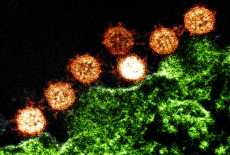SP
Size: a a a
2020 January 30
в Хубее процент смертности намного выше, наверное, из-за недообследованных, которых постепенно выявляют и добавляют в статистику. вот бы кто сделал статистику динамики по случаям и смертности без учета хубея
6K
8
братишка, не болей
AS
Геном вируса похож на SARS, статья в Lancet:
Coronavirus Genome Sequencing Finds Distinct Genetic Differences From 2003 SARS Virus
Jan 29, 2020
|
staff reporter
NEW YORK – Researchers at the Chinese Center for Disease Control and Prevention and their collaborators have sequenced the 2019 novel coronavirus (2019-nCoV) pathogen from patient samples and have found it to be genetically distinct from the severe acute respiratory syndrome (SARS) virus that caused an epidemic in 2002 and 2003, as well as from the Middle East respiratory syndrome (MERS) virus that was detected in 2012.
As they described on Wednesday in The Lancet, the researchers sequenced samples from bronchoalveolar lavage fluid and cultured isolates from nine inpatients, eight of whom had visited the Huanan seafood market in Wuhan, China. Four samples were sent to BGI for sequencing on the company's DNBSEQ-T7 platform. In addition, Chinese CDC researchers obtained complete and partial 2019-nCoV genome sequences from six of the samples (two from the same patient) using a combination of Sanger, Illumina, and Oxford Nanopore sequencing. Viral contigs were connected using Sanger sequencing to obtain the full-length genomes and the researchers determined the terminal regions by rapid amplification of the cDNA ends.
In all, they developed ten genome sequences of 2019-nCoV from the nine patients, eight of which were complete. They then performed a phylogenetic analysis of the 2019-nCoV genomes and other coronavirus genomes to determine the evolutionary history of the new virus and to help infer its likely origin.
"Notably, 2019-nCoV was closely related (with 88 percent identity) to two bat-derived severe acute respiratory syndrome (SARS)-like coronaviruses, bat-SL-CoVZC45 and bat-SL-CoVZXC21, collected in 2018 in Zhoushan, eastern China, but were more distant from SARS-CoV (about 79 percent) and MERS-CoV (about 50 percent)," the authors wrote. "Phylogenetic analysis revealed that 2019-nCoV fell within the subgenus Sarbecovirus of the genus Betacoronavirus, with a relatively long branch length to its closest relatives, bat-SL-CoVZC45 and bat-SL-CoVZXC21, and was genetically distinct from SARS-CoV." https://www.genomeweb.com/genetic-research/coronavirus-genome-sequencing-finds-distinct-genetic-differences-2003-sars-virus#.XjMbhrfTU0M
Coronavirus Genome Sequencing Finds Distinct Genetic Differences From 2003 SARS Virus
Jan 29, 2020
|
staff reporter
NEW YORK – Researchers at the Chinese Center for Disease Control and Prevention and their collaborators have sequenced the 2019 novel coronavirus (2019-nCoV) pathogen from patient samples and have found it to be genetically distinct from the severe acute respiratory syndrome (SARS) virus that caused an epidemic in 2002 and 2003, as well as from the Middle East respiratory syndrome (MERS) virus that was detected in 2012.
As they described on Wednesday in The Lancet, the researchers sequenced samples from bronchoalveolar lavage fluid and cultured isolates from nine inpatients, eight of whom had visited the Huanan seafood market in Wuhan, China. Four samples were sent to BGI for sequencing on the company's DNBSEQ-T7 platform. In addition, Chinese CDC researchers obtained complete and partial 2019-nCoV genome sequences from six of the samples (two from the same patient) using a combination of Sanger, Illumina, and Oxford Nanopore sequencing. Viral contigs were connected using Sanger sequencing to obtain the full-length genomes and the researchers determined the terminal regions by rapid amplification of the cDNA ends.
In all, they developed ten genome sequences of 2019-nCoV from the nine patients, eight of which were complete. They then performed a phylogenetic analysis of the 2019-nCoV genomes and other coronavirus genomes to determine the evolutionary history of the new virus and to help infer its likely origin.
"Notably, 2019-nCoV was closely related (with 88 percent identity) to two bat-derived severe acute respiratory syndrome (SARS)-like coronaviruses, bat-SL-CoVZC45 and bat-SL-CoVZXC21, collected in 2018 in Zhoushan, eastern China, but were more distant from SARS-CoV (about 79 percent) and MERS-CoV (about 50 percent)," the authors wrote. "Phylogenetic analysis revealed that 2019-nCoV fell within the subgenus Sarbecovirus of the genus Betacoronavirus, with a relatively long branch length to its closest relatives, bat-SL-CoVZC45 and bat-SL-CoVZXC21, and was genetically distinct from SARS-CoV." https://www.genomeweb.com/genetic-research/coronavirus-genome-sequencing-finds-distinct-genetic-differences-2003-sars-virus#.XjMbhrfTU0M
E
ситуация с коронавирусом чем-то напоминает игру Plague.Inc, в которой незаметно надо было заразить и уничтожить мир
2020 January 31
A
The Coronavirus won't last long
It was made in China
#illness
It was made in China
#illness
A

Очередные паникеры. Заголовок можно перефразировать как "смертность уханьского вируса осталась без изменений на уровне 2%"
A

Очередные паникеры. Заголовок можно перефразировать как "смертность уханьского вируса осталась без изменений на уровне 2%"
Это они нагоняют панику чтобы временно отвлечь людей от настоящих проблем
A
Это они нагоняют панику чтобы временно отвлечь людей от настоящих проблем
От протестов!
A
Таких как нехватка масок в гк
A
От протестов!
Ооо жду статью SCMP о том что перебои с масками начались из-за протестов
A
ВОЗ разродилась заявлением о чрезвычайной ситуации в международной масштабе, значит можно успокоиться
Если бы было децствительно плохо, ждали бы до последнего
Если бы было децствительно плохо, ждали бы до последнего
A
Уханьский вирус начался из-за протестов!
A
A
A
Это сейчас или уже было?
AS
т
AS

Очередные паникеры. Заголовок можно перефразировать как "смертность уханьского вируса осталась без изменений на уровне 2%"
Это абсолютно неправильно. Делить надо количество погибших на количество заражённых несколько дней назад, так как люди умирают не сразу после выявления у них вируса. Если брать срок в неделю, то получается минимум 10% смертность. И это при учёте того, что сейчас больным оказывается вся возможная помощь. Когда лекарств и больничных коек хватать не будет - смертность будет гораздо выше.
A
С койками все в порядке, еще и с запасом хватает




